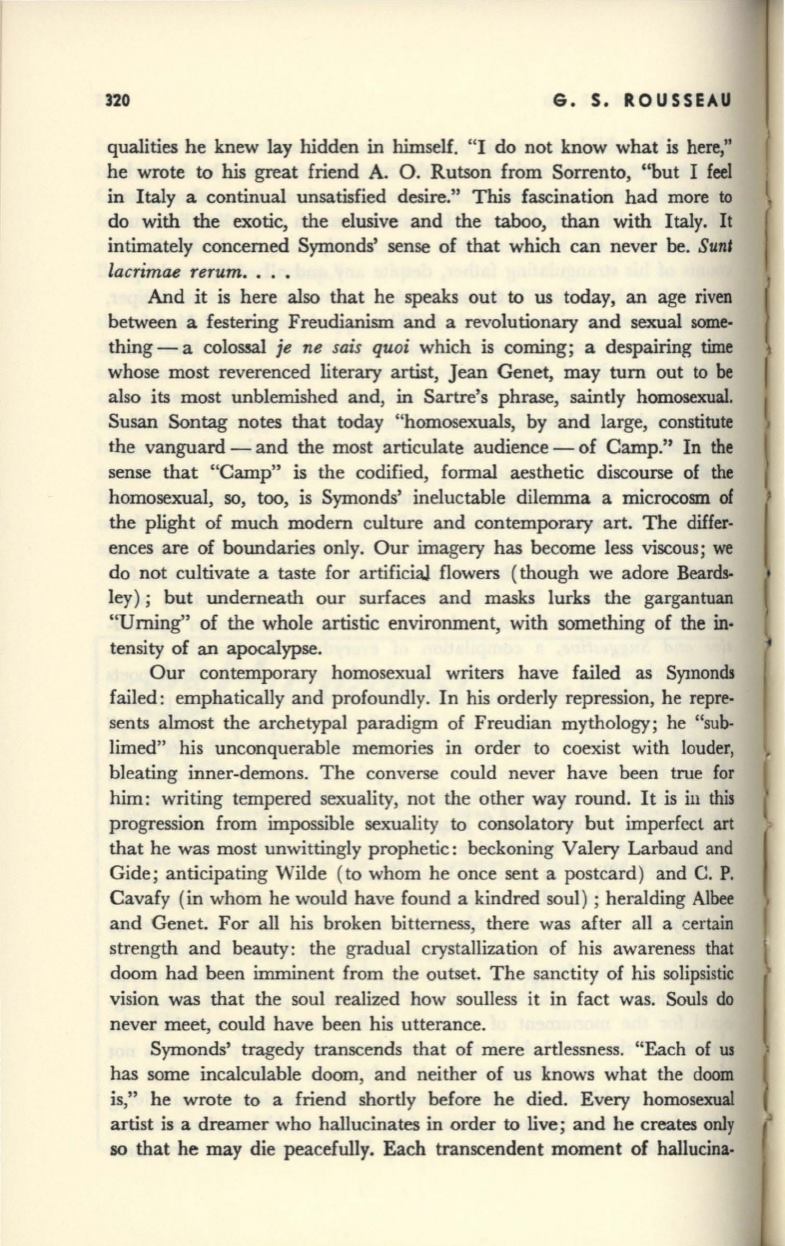
320
G. S.
ROUSSEAU
qualities he knew lay hidden
in
himself. "I do not know what
is
here,"
he wrote to his great friend A. O. Rutson from Sorrento, "but I
feel
in Italy a continual unsatisfied desire." This fascination had more
to
do with the exotic, the elusive and the taboo, than with Italy. It
intimately concerned Symonds' sense of that which can never be.
Sun'
lacrimae rerum.
. . .
And it is here also that he speaks out
to
us today, an age riven
between a festering Freudianism and a revolutionary and sexual some–
thing - a colossal
je ne sais quoi
which is coming; a despairing time
whose most reverenced literary artist, Jean Genet, may tum out to
be
also its most unblemished and, in Sartre's phrase, saintly homosexual.
Susan Sontag notes that today "homosexuals, by and large, constitute
the vanguard - and the most articulate audience - of Camp." In the
sense that "Camp" is the codified, formal aesthetic discourse of the
homosexual, so, too, is Symonds' ineluctable dilemma a microcosm of
the plight of much modem culture and contemporary art. The differ–
ences are of boundaries only. Our imagery has become less viscous;
we
do not cultivate a taste for artificial flowers (though we adore Beards–
ley); but underneath our surfaces and masks lurks the gargantuan
"Urning" of the whole artistic environment, with something of the
in–
tensity of an apocalypse.
Our contemporary homosexual writers have failed as Symonds
failed: emphatically and profoundly. In his orderly repression, he repre–
sents almost the archetypal paradigm of Freudian mythology; he "sub–
limed" his unconquerable memories in order to coexist with louder,
bleating inner-demons. The converse could never have been true for
him: writing tempered sexuality, not the other way round. It is ill this
progression from impossible sexuality to consolatory but imperfect
art
that he was most unwittingly prophetic: beckoning Valery Larbaud and
Gide; anticipating Wilde (to whom he once sent a postcard) and C. P.
Cavafy
(in
whom he would have found a kindred soul) ; heralding Albee
and Genet. For all his broken bitterness, there was after all a certain
strength and beauty: the gradual crystallization of his awareness that
doom had been imminent from the outset. The sanctity of his solipsistic
vision was that the soul realized how soulless it in fact was. Souls do
never meet, could have been his utterance.
Symonds' tragedy transcends that of mere artlessness. "Each of us
has some incalculable doom, and neither of us knows what the doom
is," he wrote to a friend shortly before he died. Every homosexual
artist is a dreamer who hallucinates in order to live; and he creates only
so that he may die peacefully. Each transcendent moment of hallucina-


